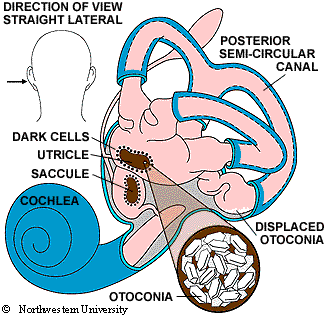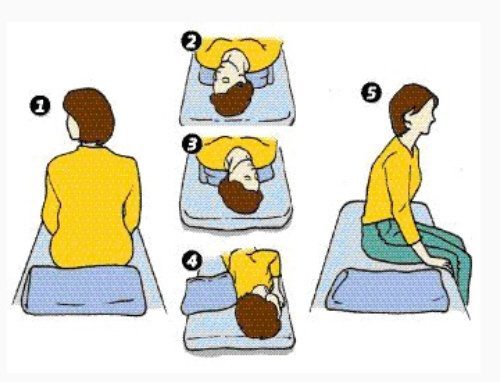By Barry Keate
Barry Keate, has lived with tinnitus over 40 years and has published 150+ research articles on numerous aspects of tinnitus. He is an expert on the condition and a well-known advocate for those with tinnitus.
Vertigo is an inner ear disorder, which has many causes. The most common, especially among older people, is BPPV – Benign Paroxysmal Positional Vertigo. Unlike other causes of vertigo, this condition can be treated by simple physical manipulations, either in a doctor’s office or at home.
Causes of Vertigo
Vertigo can be caused by several medical conditions. Meniere’s disease is thought to be caused by a buildup of fluid and pressure in the vestibular portion of the inner ear. It causes episodes of vertigo along with tinnitus, hearing loss, and a feeling of fullness in the ear. Meniere’s disease must be treated by medical means.
Vestibular neuritis, or labyrinthitis, is usually related to a viral infection which causes inflammation in the inner ear around nerves that are vital for helping the body’s sense of balance.
Other causes of vertigo include head or neck injury, brain problems that may include stroke or tumor, some medications, and migraine headaches.
Benign Paroxysmal Positional Vertigo
BPPV is the most common cause of vertigo, which is a false sensation of spinning. This difficult sounding name can be easily understood when it is broken down.
Benign – it is not life threatening
Paroxysmal – it comes in sudden, brief spells
Positional – It is triggered by certain head positions or movements
Vertigo – A false sense of rotational movement
BPPV occurs because of a mechanical problem in the vestibular section of the inner ear. It happens when some of the calcium carbonate crystals (otoconia) that are normally embedded in the gel of the utricle become dislodged and move into one or more of the 3 fluid-filled semicircular canals. These particles interfere with the normal fluid movement that these canals use to sense head motion, causing the inner ear to send false signals to the brain. (1)

Fluid in the semicircular canals does not react to gravity. But the crystals do move with gravity, thereby moving the fluid when it would normally be still. When the fluid moves, nerve endings in the canal are excited and send a message to the brain that the head is moving, even though it isn’t. This information doesn’t match with the other ear, with what the eyes are seeing, or with what the muscles and joints are doing. This mismatch is perceived by the brain as a spinning sensation, or vertigo.
It is important to know that BPPV will not cause permanent dizziness, will not affect hearing or produce fainting, headache or neurological symptoms, trouble speaking, or coordinating movements. If any of these or other additional symptoms occur, consult with your healthcare provider immediately.
BPPV is fairly common, with an estimated incidence of 107 per 100,000 per year and a lifetime prevalence of 2.4%. It is extremely rare in children but can affect adults of any age, especially seniors. The great majority of cases appear for no apparent reason, with many people saying they got out of bed in the morning and the room started to spin. Between vertigo spells some people feel vertigo free while others feel a mild sense of imbalance.
General practitioners typically refer patients to a vestibular rehabilitation specialist (a specially trained physical therapist) or an ENT who focuses on vestibular disorders. When someone with BPPV has their head moved into a position that makes the dislodged crystals move, the error signals cause the eyes to move in a very specific pattern, called nystagmus. This eye movement will allow a trained practitioner to identify which ear the displaced crystals are in and which canals they have moved into. BPPV typically involves only one ear but in about 5% of cases, it can occur in both.
BPPV Treatment
Some physicians in the past have resorted to medication to reduce vertigo although there is no scientific support for this treatment. Fortunately, in the vast majority of cases, BPPV can be corrected mechanically. The physical maneuvers use gravity to guide the crystals back into the chamber where they are supposed to be by using a specific series of head movements.
The most frequent treatment is called the Epley Maneuver. It is used for the most common form of BPPV. However, that will not work for all types of BPPV and caution should be used with self-treatment as non-specialists will not recognize the many different variants of the condition and which treatment maneuvers to make.
The Epley Maneuver
A doctor doing the Epley maneuver will manually move a person into a series of positions. It can also be done at home but is best if someone assists in the motions.
1 – The person sits upright, with legs fully extended, on the exam table or a bed.
2 – Rotate the person’s head at a 45 degree angle towards the side they are experiencing the worst vertigo.
3 – Quickly push the person back so they are laying down with shoulders at the edge and the head facing the worst side but with the head below the edge and at a 30 degree angle toward the same side. Hold the person in this position for between 30 seconds and 2 minutes, until the dizziness subsides.

4 – Rotate the head 90 degrees in the opposite direction to 30 degrees on the other side. Hold the position until the dizziness subsides.
5 – Roll the person in the same direction they are facing, onto their side. Hold until dizziness subsides.
6 – Bring the person back to the sitting position.
7 – Repeat up to three times until symptoms are relieved.
There are many good videos of this procedure on YouTube.
Many studies have been conducted into the effectiveness of treatment maneuvers for BPPV, with results showing rates of resolution into the 90% range after 1-3 treatments. Unfortunately, BPPV can recur periodically with recurrence rates as high as 50% within 5 years. This is especially true for those who have the condition related to physical trauma.
References:
1 – Vestibular Disorders Association. http://vestibular.org/understanding-vestibular-disorders/types-vestibular-disorders/benign-paroxysmal-positional-vertigo
Get Free Shipping!
Order now and get free shipping on either the Tinnitus Starter Kit or Combo Pack. Try the doctor recommended products with clinically proven ingredients for tinnitus. No coupon code required.

